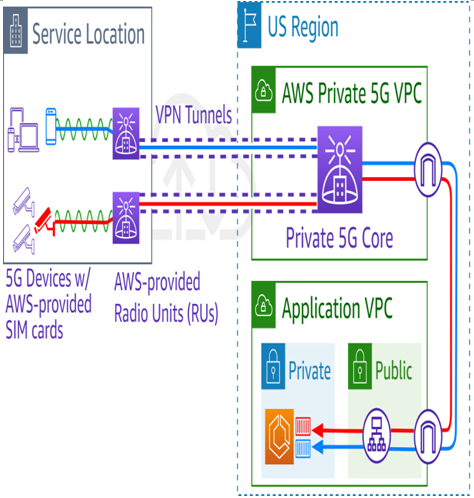Private MEC – Utilizing Public 5G Networks for Multi-Access Edge (MEC) Architectures
Some customers wish to build their own private 5G networks and offer MEC to their customers only. Often, these customers are subordinate companies of an overarching conglomerate, or sometimes they are public sector entities. For instance, the State of California might decide to offer MEC services only to county- or municipal-level entities within certain geographies:

Figure 10.8 – Devices accessing ECS containers over AWS Private 5G
The preceding diagram illustrates a way to implement private MEC using the AWS Private 5G service with customer applications hosted on ECS containers in-region. As with any other MEC solution, we can take advantage of the fact that additional general-purpose compute is available in the same place the 5G UPF is hosted via NFV.
Observability, security, and capacity of Wi-Fi versus 5G
When considering general-purpose wireless technologies for a new architecture, the decision is typically 802.11x-based Wi-Fi or 5G. When both are available, which one makes the most sense is usually driven by the observability, security, and capacity needs of the application in question.
Observability
Wi-Fi networks, typically deployed in confined areas such as homes or offices, face challenges related to interference, especially in densely populated environments. Observability can be hindered due to overlapping channels, signal interference from physical obstacles, and the presence of multiple devices competing for access. Tools for Wi-Fi observability, such as network analyzers, provide insights into network health but are expensive, and the onus often lies with local administrators to monitor and maintain optimal performance.
These tools were developed in response to needs in the field, in most cases long after the 802.11x specifications were developed. As an architect, when you implement a Wi-Fi-based solution, you must integrate these tools and build associated reporting mechanisms for them from the start – they must not be an afterthought or your user experience will almost certainly be poor, and intermittently poor at that.
5G, on the other hand, was developed by a consortium of MNOs. These are Service Providers (SPs) who maximize profits by centralizing such things as much as possible. Therefore, sophisticated QoS mechanisms such as network slicing are heavily instrumented, and the expensive tooling is centralized and exposed to customers via standard APIs.
What this means for you as an architect is you can simply tell the MNO you are working with what network slices and performance SLAs you need for each. They provision them, and you are given an API-based reporting interface that proves each slice on each device is both available and performing to the level you are paying for.